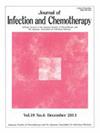Antimicrobial activity of tebipenem to Escherichia coli isolates from outpatients with complicated urinary tract infections
IF 1.9
4区 医学
Q3 INFECTIOUS DISEASES
引用次数: 0
Abstract
Extended-spectrum β-lactamases (ESBL)-producing Escherichia coli have emerged as a global concern in urinary tract infections (UTIs). This study investigated the susceptibility of clinical isolates of E. coli from complicated UTIs (cUTIs) to tebipenem pivoxil (TBPM), an oral carbapenem developed in Japan. In 2019, 229 non-ESBL-producing and 61 ESBL-producing E. coli strains were collected from five major hospitals in the Gifu Prefecture. Susceptibility was assessed following the Clinical and Laboratory Standards Institute guidelines (M07 and M100), and TBPM was compared with other commonly used antibiotics. The MIC50 and MIC90 values of TBPM for non-ESBL and ESBL-producing E. coli were ≤0.03 μg/mL, with MIC ranges of ≤0.03–0.25 μg/mL and ≤0.03–0.06 μg/mL, respectively, indicating its strong antimicrobial activity. Notably, no strains demonstrated reduced susceptibility to TBPM. These results were comparable to those of intravenous carbapenems such as imipenem and meropenem. Additionally, these findings align with the national Japanese surveillance data, suggesting that the trends observed in this study may reflect broader patterns across Japan. In the United States, an ongoing study is evaluating TBPM hydrobromide for cUTIs, highlighting its potential as an effective oral carbapenem. TBPM may be a promising treatment option for cUTIs caused by ESBL-producing E. coli, offering an alternative to intravenous therapies and potentially reducing the need for hospitalization. However, careful use of TBPM in antimicrobial stewardship programs is crucial to prevent resistance and ensure its continued efficacy in outpatient settings.
替比培南对门诊并发尿路感染患者大肠杆菌的抑菌活性研究
广谱β-内酰胺酶(ESBL)产生大肠杆菌已成为全球关注的尿路感染(uti)。本研究研究了来自复杂尿路感染(cUTIs)的大肠杆菌临床分离株对日本开发的口服碳青霉烯类药物-泰比培烯酯(TBPM)的敏感性。2019年,在岐阜县5家主要医院共采集到229株非产esbl大肠杆菌和61株产esbl大肠杆菌。根据临床和实验室标准协会指南(M07和M100)评估药敏,并比较TBPM其他常用抗生素。TBPM对非esbl和产生esbl的大肠杆菌的MIC50和MIC90值均≤0.03 μg/mL, MIC范围分别为≤0.03 ~ 0.25 μg/mL和≤0.03 ~ 0.06 μg/mL,表明其具有较强的抗菌活性。值得注意的是,没有菌株表现出对TBPM的易感性降低。这些结果与静脉注射碳青霉烯类药物如亚胺培南和美罗培南的结果相当。此外,这些发现与日本全国监测数据一致,表明本研究中观察到的趋势可能反映了整个日本的更广泛模式。在美国,一项正在进行的研究正在评估氢溴化TBPM治疗cUTIs,强调其作为有效口服碳青霉烯类药物的潜力。TBPM可能是由产生esbl的大肠杆菌引起的cUTIs的一种有希望的治疗选择,提供静脉注射治疗的替代方案,并可能减少住院治疗的需要。然而,在抗菌药物管理规划中谨慎使用TBPM对于预防耐药性和确保其在门诊环境中的持续有效性至关重要。
本文章由计算机程序翻译,如有差异,请以英文原文为准。
求助全文
约1分钟内获得全文
求助全文
来源期刊

Journal of Infection and Chemotherapy
INFECTIOUS DISEASES-PHARMACOLOGY & PHARMACY
CiteScore
4.10
自引率
4.50%
发文量
303
审稿时长
47 days
期刊介绍:
The Journal of Infection and Chemotherapy (JIC) — official journal of the Japanese Society of Chemotherapy and The Japanese Association for Infectious Diseases — welcomes original papers, laboratory or clinical, as well as case reports, notes, committee reports, surveillance and guidelines from all parts of the world on all aspects of chemotherapy, covering the pathogenesis, diagnosis, treatment, and control of infection, including treatment with anticancer drugs. Experimental studies on animal models and pharmacokinetics, and reports on epidemiology and clinical trials are particularly welcome.
 求助内容:
求助内容: 应助结果提醒方式:
应助结果提醒方式:


